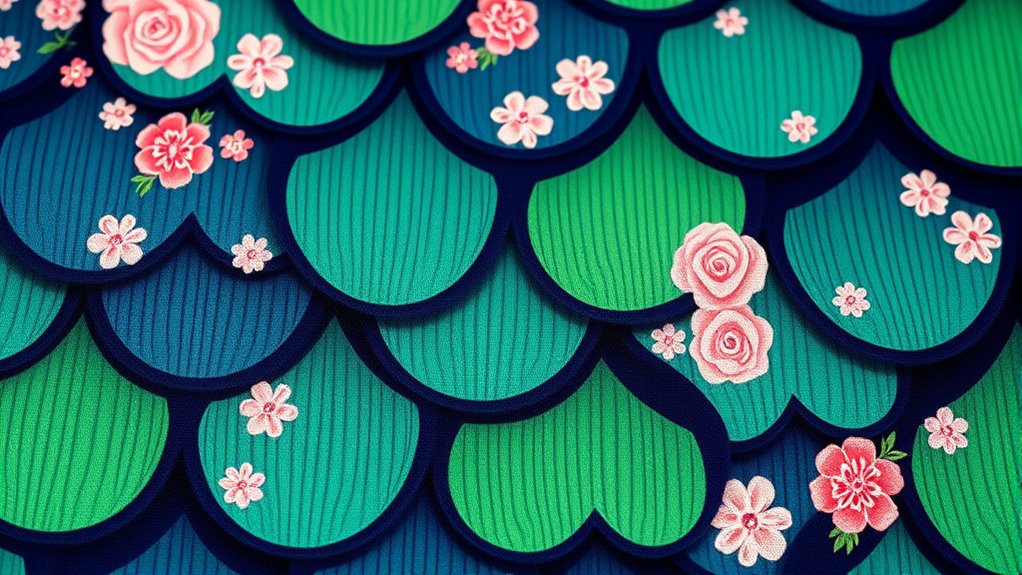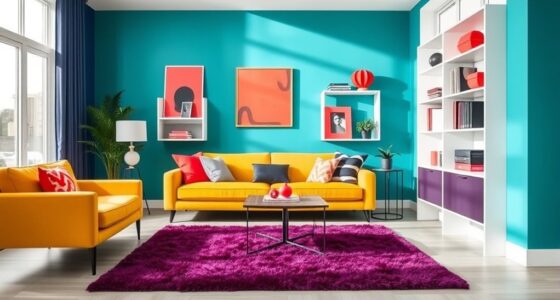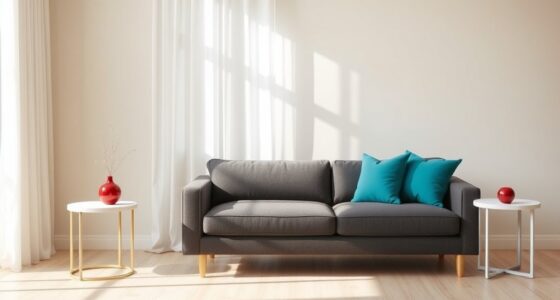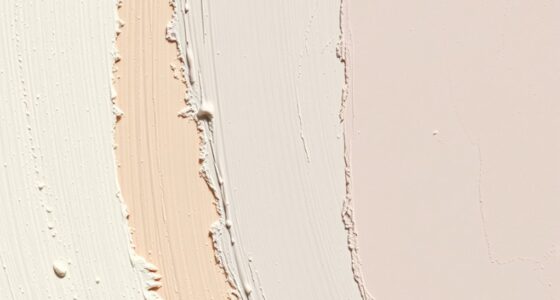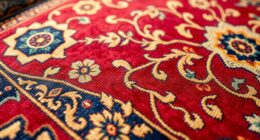When mixing large and small prints, focus on balance and contrast to create visual harmony. Use large patterns as focal points or anchors, while small prints add texture and subtle detail. Pair bold prints with delicate ones, ensuring your color palette ties everything together. Avoid clashing styles or pattern sizes that are too similar to prevent flatness. Mastering scale and contrast helps you achieve engaging, cohesive designs—if you keep exploring, you’ll uncover more tips on perfect pattern pairing.
Key Takeaways
- Combine large prints with small prints to create visual interest and maintain balance.
- Use large patterns as focal points, complemented by subtle, small-scale prints for cohesion.
- Ensure color harmony across different scales to unify the overall design.
- Balance contrasting scales to prevent one pattern from overwhelming the space.
- Incorporate texture and neutral tones to enhance harmony between large and small patterns.
The Impact of Scale on Visual Balance
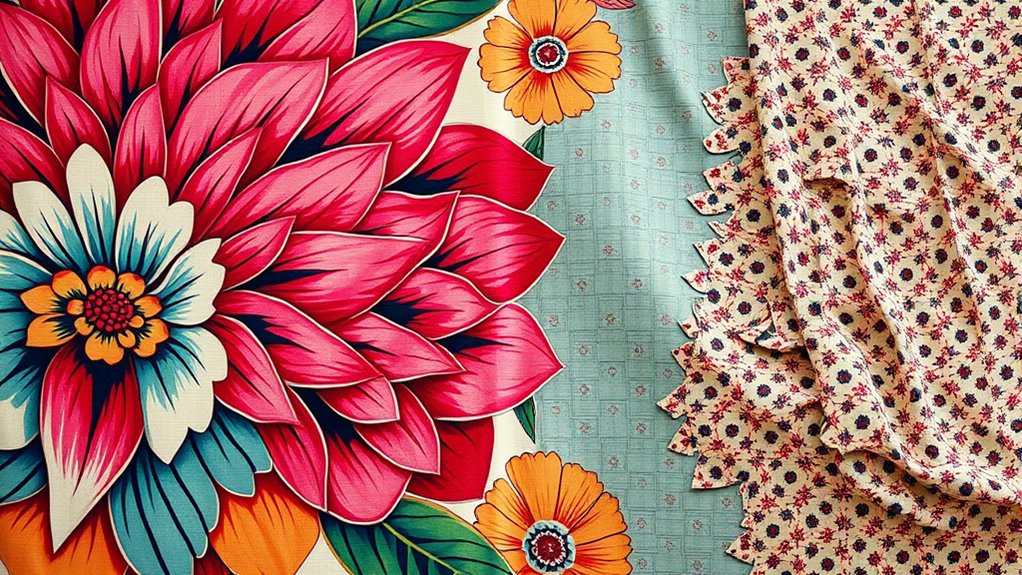
Scale plays a crucial role in achieving visual balance within a design. When you consider scale contrast, you create focal points that draw attention without overwhelming the entire space. Large patterns can anchor a room, providing a sense of stability, while smaller prints add detail and texture that keep the design lively. Balancing these contrasting scales ensures visual harmony, preventing any one element from dominating. If you use too many small prints, your space might feel cluttered or busy; too many large patterns can make it feel heavy or chaotic. By thoughtfully mixing different pattern scales, you guide the eye naturally across your design, creating a cohesive and visually appealing environment. Moreover, understanding visual weight helps you achieve balance and harmony in your space. Ultimately, understanding how scale impacts balance helps you craft a space that feels both dynamic and harmonious.
When to Use Large Prints as Focal Points
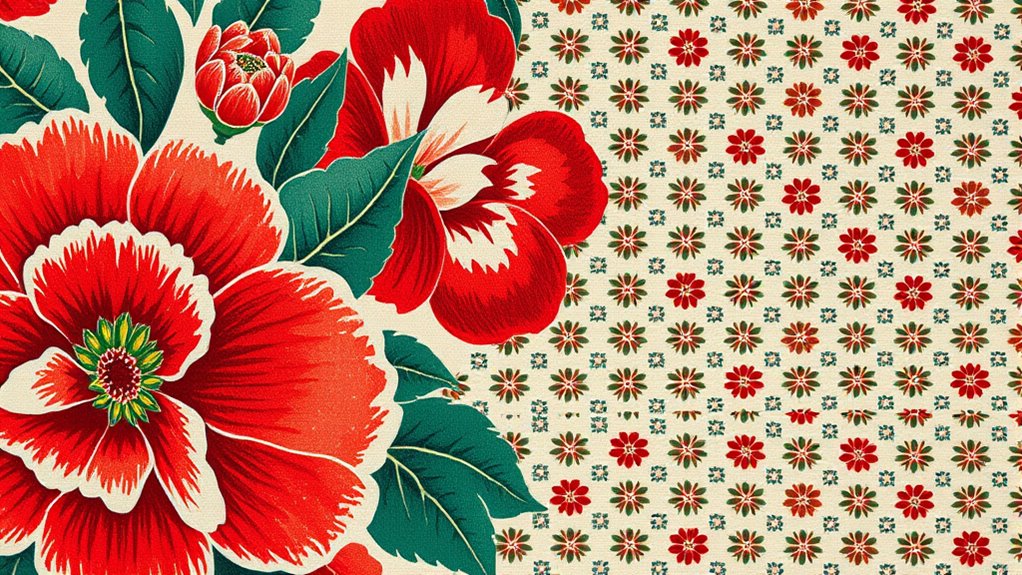
Using large prints strategically can transform a space by creating striking focal points that immediately draw attention. When you want to make a bold statement emphasis, large prints are your go-to choice. They work best when you aim to highlight a specific area, such as an accent wall, a sofa, or a centerpiece in a room. Large prints naturally become focal points, so use them sparingly to avoid overwhelming the space. This technique is especially effective in minimalist or neutral settings, where one large pattern can add visual interest without clutter. Remember, the goal is to create a visual anchor that guides the eye and defines the room’s style. Use large prints thoughtfully, ensuring they enhance rather than overpower your overall design. Incorporating a visual hierarchy helps balance large prints with other design elements, maintaining harmony in your space.
Incorporating Small Prints for Texture and Depth
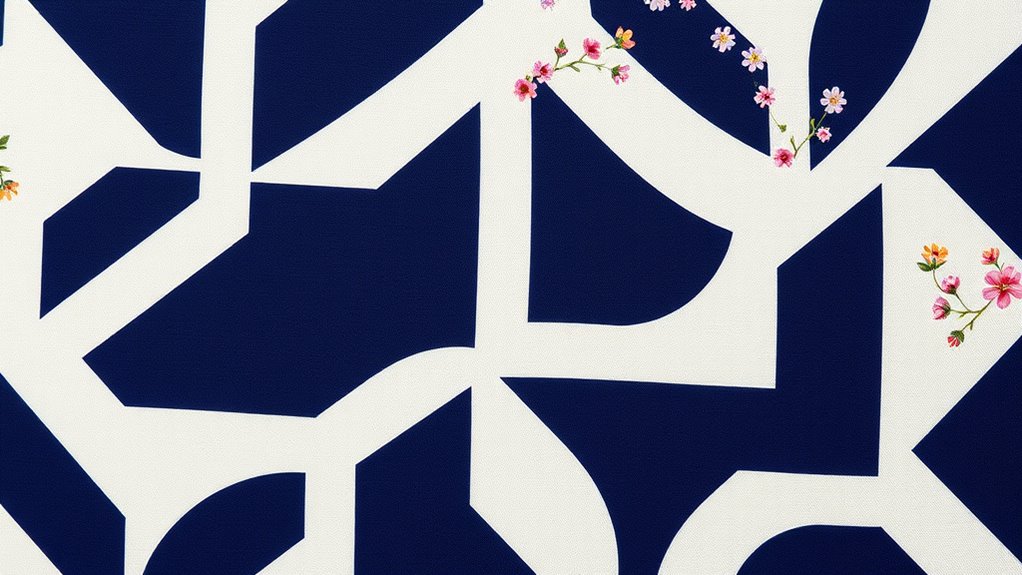
Have you considered how small prints can subtly enhance a room’s texture and depth? Incorporating tiny patterns creates opportunities for texture layering without overwhelming the space. Small prints add visual depth by breaking up larger solid surfaces, giving your room a richer, more inviting feel. Use them on accent pillows, throws, or wallpapers to introduce intricate details that catch the eye without dominating the design. These subtle patterns work well with larger prints, creating a balanced and cohesive look. The key is to select small prints with varying textures or delicate motifs, which add complexity and sophistication. By thoughtfully integrating small prints, you can elevate your space’s overall depth and tactile interest, making your room feel layered, dynamic, and visually engaging. Additionally, pattern scale plays a crucial role in achieving harmony between different prints, ensuring that neither overwhelms the other, and contributes to a cohesive design.
Strategies for Pairing Different Print Sizes
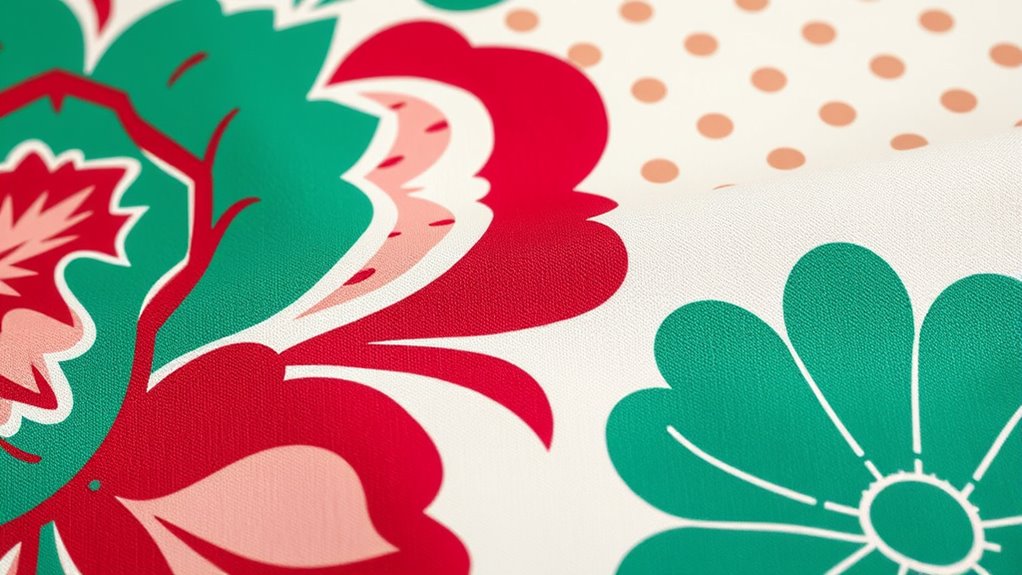
Pairing different print sizes effectively requires a thoughtful approach to balance and harmony. Emphasize scale contrast by combining large and small patterns, ensuring they complement rather than compete. For example, pair a bold, large print with a subtle, tiny pattern to create visual interest without overwhelming the eye. Pattern harmony is key; choose prints with similar color palettes or motifs to unify the look. Avoid mixing wildly different styles that clash, and instead focus on cohesive combinations that enhance each other. Play with the placement by balancing prints across your outfit or space to prevent one pattern from dominating. Additionally, considering the texture and finish of fabrics can add depth and dimension to your pairing. By carefully considering scale contrast and maintaining pattern harmony, you’ll create a visually appealing, well-balanced ensemble or room that feels intentional and stylish.
Achieving Harmony With Contrasting Scales
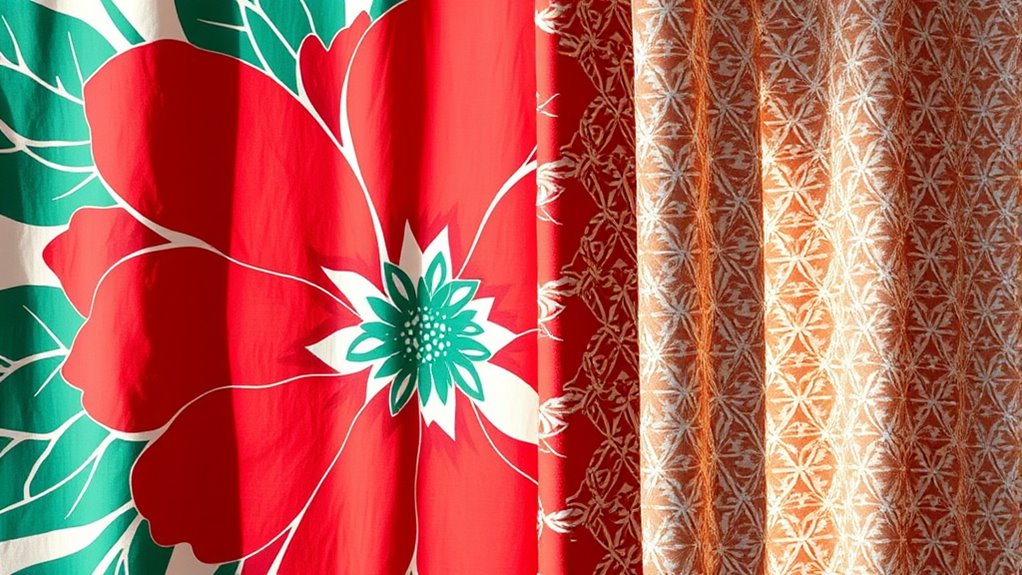
Achieving harmony with contrasting scales involves skillfully balancing different pattern sizes so they work together seamlessly. To do this, focus on creating textural contrast, where large patterns add visual weight and small prints bring subtle detail. This contrast enhances depth without overwhelming the space. Scale harmony is key; verify the sizes complement rather than clash. Pairing a bold, large-scale print with a delicate, small-scale pattern creates visual interest while maintaining cohesion. Use neutral tones or consistent color palettes to unify contrasting scales. Keep the overall design balanced by distributing patterns thoughtfully across the space. When done correctly, contrasting scales can energize a room, adding richness and dimension without sacrificing harmony. Understanding visual balance is essential to achieving a harmonious interior design. The goal is to make each pattern work together to elevate your interior.
Tips for Mixing Prints in Interior Design

Mixing prints in interior design can add personality and vibrancy to your space, but it requires a strategic approach. To succeed, focus on creating pattern contrast by combining prints with different motifs and textures, preventing the design from feeling monotonous. Equally important is ensuring scale harmony; balance larger prints with smaller ones so they complement each other without overwhelming the room. When you mix patterns, start with a neutral base and introduce one or two bold prints, then layer in smaller, subtle patterns to tie everything together. Keep the color palette cohesive to maintain unity. Additionally, understanding scale harmony can help you choose the right print sizes for a balanced look. Remember, the key is to experiment thoughtfully—trust your eye, and don’t be afraid to break traditional rules for a unique, lively space.
Styling Outfits With Varied Pattern Sizes
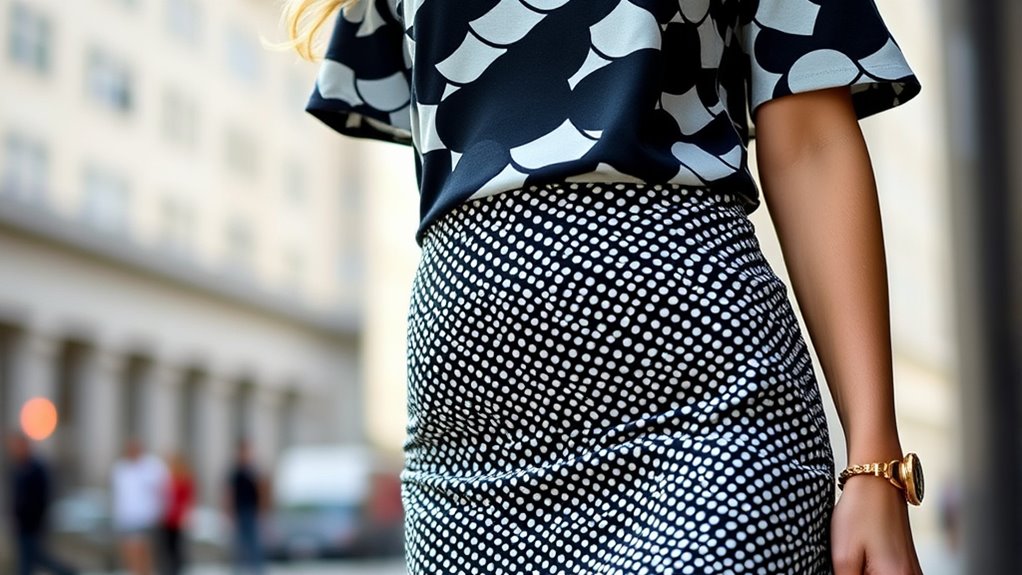
When styling outfits with varied pattern sizes, balancing the different elements is key to creating a cohesive look. Start by pairing patterns with similar fabric textures to guarantee harmony, such as mixing smooth silks with matte knits. Pay attention to pattern symmetry; matching or contrasting symmetrical designs can create visual interest without overwhelming the eye. For example, combine a small, intricate pattern with a larger, bold print, making sure one doesn’t overshadow the other. Use neutral or solid pieces to anchor the look, allowing the varied patterns to stand out. Keep accessories minimal to avoid clutter. By thoughtfully blending fabric textures and respecting pattern symmetry, you craft a stylish, balanced outfit that highlights both the diversity and unity of your pattern choices. Incorporating pattern contrast techniques can further enhance visual harmony and prevent the look from appearing chaotic.
Common Mistakes to Avoid When Combining Prints
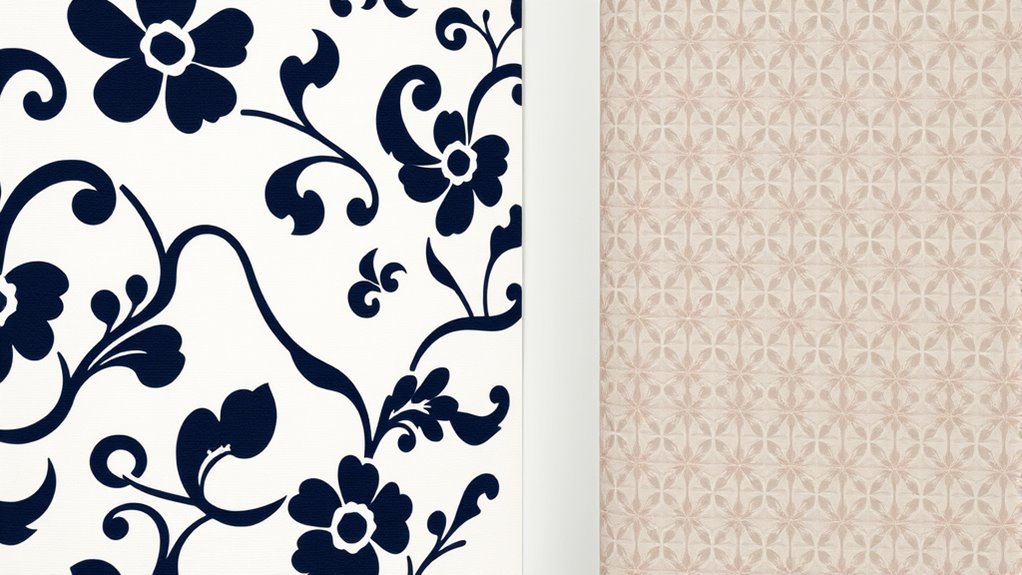
Avoid overmatching patterns, as it can make your outfit look busy and overwhelming. Pay attention to scale contrast so your prints complement rather than compete with each other. Also, don’t forget to coordinate colors to create a harmonious and balanced look. Incorporating encryption techniques can help you safeguard your personal style choices and ensure your fashion secrets stay private.
Overmatching Patterns Too Much
While experimenting with different prints can create a bold and stylish look, overmatching patterns can quickly become overwhelming. Pattern overmatching happens when you combine too many prints without considering harmony, leading to excessive clashing. This mistake can make your outfit look chaotic rather than chic. To avoid this, stick to a cohesive color palette and limit the number of patterns you mix. Pairing small prints with larger ones can help balance the look, but overdoing it results in visual confusion. Remember, the key is moderation—adding just one or two prints creates interest without overwhelming the eye. Incorporating rustic decor elements can also help tie the patterns together and create a more harmonious appearance. By being mindful of pattern overmatching, you’ll create more intentional, stylish outfits that showcase your flair without crossing into chaos.
Ignoring Scale Contrast
Ignoring scale contrast can quickly undermine your efforts to create a balanced, stylish print mix. Without paying attention to scale hierarchy, you risk one pattern overpowering the others, disrupting visual harmony. Pattern dominance becomes skewed if all prints are similar in size, making the outfit look flat or chaotic. To avoid this mistake:
- Mix large and small prints intentionally to establish a clear scale hierarchy
- Ensure no single pattern dominates the ensemble, balancing prominence
- Vary the size of your prints to create visual interest and depth
- Be mindful of how scale affects overall pattern coordination and cohesion
- Recognize that print size differences play a crucial role in achieving a harmonious look
Neglecting Color Coordination
Neglecting color coordination when mixing prints can quickly lead to a jarring and unharmonious outfit. Without attention to color harmony, your look may feel disjointed, even if the patterns themselves work well together. To avoid this, focus on pattern repetition and matching hues. Use the table below to guide your choices:
| Color Scheme | Pattern Repetition | Contrast Level |
|---|---|---|
| Monochrome | Yes | Low |
| Complementary | No | Medium |
| Analogous | Yes | Soft |
| Contrasting | No | High |
Additionally, understanding how to apply skincare patches effectively can enhance your overall skincare routine, ensuring your skin stays healthy and blemish-free.
Using Color to Unite Different Pattern Scales
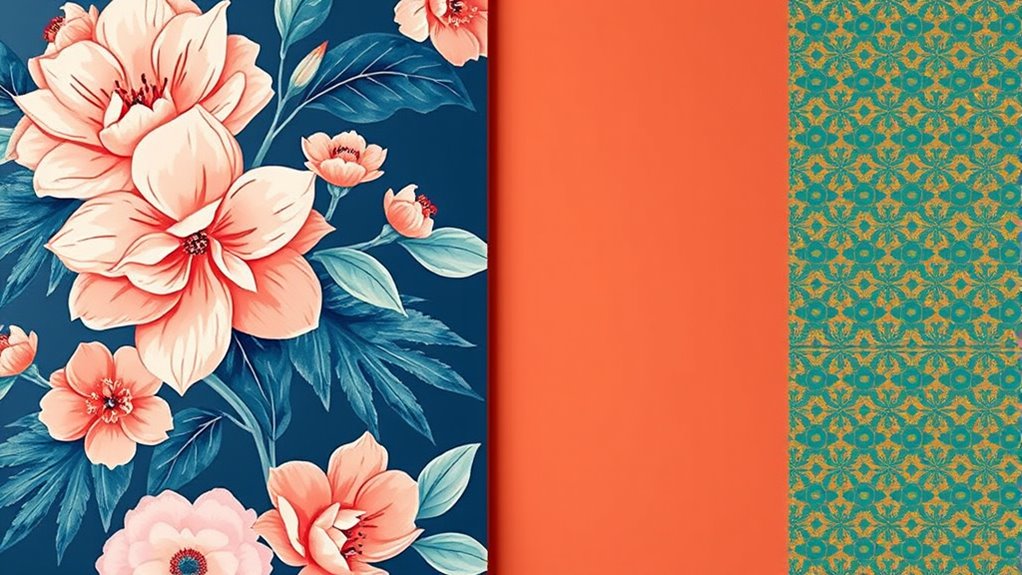
Using color is a powerful way to create harmony between different pattern scales. When you choose a unifying color palette, your varied prints will feel cohesive rather than chaotic. This approach helps your overall design look intentional and balanced.
Harmonizing Colors and Patterns
When you want to create a cohesive look despite varying pattern scales, color becomes your most powerful tool. Use consistent hues to tie different patterns together, making even contrasting prints feel harmonious. Incorporate pattern repetition by echoing a specific color across various prints, creating visual links. Color blocking is another strategy—pairing solid colors with patterned pieces to balance scale differences. Focus on a unified color palette to prevent chaos and ensure each pattern complements the others. Additionally, understanding the role of wall organization can help in visualizing how different design elements work together to create a balanced aesthetic.
Creating Visual Cohesion
Ever wonder how to make different pattern scales feel like part of a unified look? The key is using color to create visual cohesion. Choose a common color palette and repeat it across your fabrics, regardless of pattern size or texture. This pattern repetition ties the elements together, making the overall design feel intentional. Incorporate fabric textures that complement each other, like matte with glossy or smooth with textured surfaces, to add depth without clashing. Using a consistent color helps bridge large and small prints, ensuring they don’t compete but instead work harmoniously. Additionally, understanding resources and tools available for pattern coordination can help you achieve a balanced and stylish space that feels cohesive and visually appealing.
Creative Ways to Experiment With Pattern Mixing
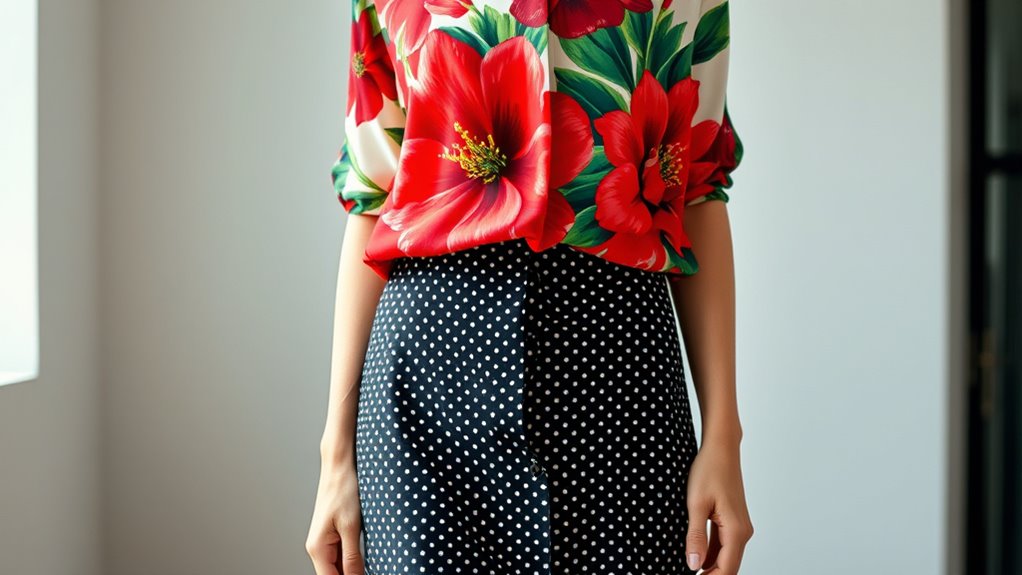
Exploring different ways to mix patterns can elevate your style and showcase your creativity. To push boundaries, try combining patterns with textural contrast—pair a smooth silk top with a textured tweed skirt for depth. Experiment with color blocking by using bold, solid-colored pieces alongside patterned items to highlight specific hues. Mix large and small prints for visual interest, balancing them carefully. Don’t shy away from layering patterns, such as striped tops with floral bottoms, to create a dynamic look. You can also introduce unexpected pairings, like polka dots with animal prints, to make a statement. Remember, the key is to have fun and trust your instincts while keeping the overall outfit cohesive and balanced. Incorporating pattern scales thoughtfully can further enhance your styling and add an extra layer of sophistication to your outfits.
Frequently Asked Questions
How Does Pattern Scale Influence the Overall Mood of a Space or Outfit?
Pattern scale considerably influences the mood of your space or outfit. Large prints create bold, energetic statements that command attention, while small prints foster scale harmony and a subtle, calming vibe. By choosing the right scale, you enhance the overall mood—whether you want vibrant excitement or understated elegance. Mixing scales thoughtfully ensures your look or room feels balanced, harmonious, and mood-enhancing, making your style or environment truly resonate.
Can Mixing Different Print Scales Create Visual Confusion or Chaos?
Mixing different print scales can sometimes lead to clashing visuals and overwhelming effects. Did you know that 65% of people find mismatched patterns distracting? When you don’t balance large and small prints carefully, your outfit or space might look chaotic. To avoid this, use a unifying color palette or keep one pattern subtle. This way, you prevent visual confusion and create a harmonious, stylish look or environment.
What Are the Best Fabric Choices for Balancing Large and Small Prints?
You should choose fabrics with similar textures, like smooth or matte finishes, to balance large and small prints. Opt for fabrics that offer pattern contrast without overwhelming each other, such as pairing a small floral with a larger geometric print. This creates visual harmony, ensuring neither pattern dominates. By focusing on fabric texture and pattern contrast, you achieve a cohesive look that keeps your outfit balanced and visually appealing.
How Do Lighting Conditions Affect the Perception of Pattern Scale?
Lighting effects can substantially influence how you perceive pattern scale, causing perception distortion. Bright, natural light tends to enhance clarity, making small prints appear sharper and larger prints more vibrant. Conversely, dim or artificial lighting can soften details, masking pattern size and creating a more uniform look. You should consider the lighting conditions in your space because they directly impact how your pattern choices will look and feel in your environment.
Are There Cultural or Historical Considerations When Pairing Pattern Sizes?
You might not realize it, but pairing pattern sizes carries a world of cultural symbolism and historical context. In some cultures, large prints symbolize power and status, while small, intricate patterns evoke tradition and craftsmanship. Over centuries, these choices reflect societal values and history. So, when you mix patterns, consider these deeper meanings—your choices can honor history or challenge cultural norms, transforming your style into a statement.
Conclusion
Mixing large and small prints is like crafting a beautiful tapestry—you need each thread to complement the others. When you understand how scale affects balance and use contrast thoughtfully, you create outfits that are lively yet harmonious. Don’t be afraid to experiment and break the rules a little. With confidence and a keen eye, you’ll master the art of pattern mixing, turning your wardrobe into a vibrant canvas that reflects your unique style.

